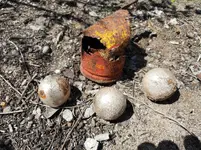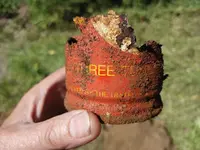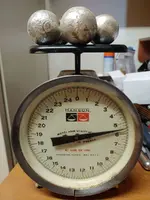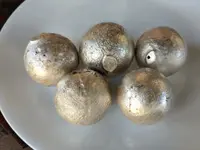I have some thoughts.
Hardness
You say “No. Not lead or zinc. It is much too hard to be those metals” which doesn’t make sense if you’re theorising it to be silver. True, lead only has a hardness of 1.5 on the Mohs scale but zinc and silver both have a hardness of 2.5 on the scale. Silver is not a naturally hard material. Depending on the way it has been annealed, the degree to which it has been subsequently worked, and whether it has minor amounts of other metals (as in Sterling silver for example) the hardness might get to 3.0, but not beyond that. Even platinum only has a hardness of 3.5 but remember the Mohs scale is an ordinal scale based on rankings and not an absolute measure of hardness.
For silver, the thing that increases hardness the most is the degree of working after annealing, but cast spheres like that with mould marks still visible cannot have been worked. There are ways to push silver hardness a bit further. For example the “Argentium” process creates a harder silver that meets the Sterling standard by replacing the usual copper content with other metals, but didn’t see commercial use until the 1990s.
It wouldn’t be difficult to check what the actual hardness might be, so I would suggest that you perform some comparative scratching tests to find out.
Tarnish
The lack of tarnish is not consistent with silver in my opinion. Again the Argentium process creates a silver which is not just harder, but also much more tarnish resistant but (as above) would have to date from the 1990s or later. Platinum of course wouldn’t tarnish.
Density
For ease of comparison with published data, I have converted the densities into specific gravities, using your weights and taking the items as perfect spheres (neither of which are likely to be completely ‘kosher’, but nevertheless I think a reasonable approximation for the purposes of guessing what they might be made from). That gives SGs of:
8.38
10.44
9.78
9.69
9.71
By comparison zinc is 7.14, silver is 10.49, lead is 11.34 and platinum is a whopping great 21.45 but if those spheres are made from an alloy, then any comparison with native metal densities only has limited validity.
Personally, I think there are more likely possibilities that are being neglected and one in particular springs to mind:
Milling Balls?
These come in various sizes and made from various materials but larger and heavier ones are typically used for things such as ‘ore-crushing’ where you’re just size-reducing the material to facilitate smelting rather than milling to produce uniformly fine powders or using them for polishing. The latter usually have a very uniform spherical surface, but there’s no need for the heavy duty ones to be so perfectly formed.
The material of choice is often tungsten carbide, which has an SG of around 15.6, a hardness between 9.0 to 9.5 and a greyish metallic colour which doesn’t tarnish. From a combination of size and weight, it’s possible to tailor the balls more specifically to suit the size and density of what is being processed, for which various tungsten alloys are used. Tungsten itself has an SG of 19.45 and a hardness of 7.5 but you can adjust that to other desired values by alloying with other metals, for which iron, nickel, copper and cobalt are commonly used. Some processors prefer at least some iron content so the balls can be recovered from the processed material with an elecctro-magnet, while others simply use a screen for separation. Tungsten itself is not magnetic and whether alloys of it exhibit magnetism depends on what it is alloyed with.
Just a thought.











 ?
? 